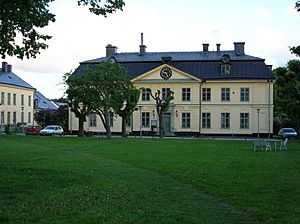Barnängens manufaktur facts for kids
Barnängens manufaktur was a big textile factory in Stockholm, Sweden. Its name means "Children's Meadow's Manufacture." It was located in an area called Barnängen ("Children's Meadow") in Södermalm. This factory was busy for a long time, from 1691 until 1826.
For much of the 1700s, Barnängens manufaktur was one of the largest factories in Stockholm. It was a major rival to another big factory called Pauliska manufakturerna. In the 1780s, Barnängens manufaktur actually employed more people than any other business in the city. Most of these workers were women. The factory's story has even been told in a novel, Vävarnas barn (Children of the Weavers), written by Per Anders Fogelström in 1981.
History of the Factory
Barnängens manufaktur was started by a person named Jacob Gavelius. He set up a textile mill in the Barnängen area in 1691. Over the years, the factory grew and added more buildings. These included the original textile mill from 1691, a building for textile workers from 1758, a main house (called a Corps de logis) from 1767, and other factory and storage buildings from 1782.
A Busy Time: The 1700s
During the 1700s, Barnängens manufaktur was one of the two biggest factories in Stockholm. Its main competitor was Pauliska manufakturerna. Barnängens manufaktur employed more people than any other business in the capital city. Many of its workers were women. For example, in 1745, 416 out of 529 employees were women. By the 1780s, it was the largest industry in Stockholm.
The workers at Barnängens manufaktur did not always work inside the factory buildings. Many of them set up small Workshops in their own homes or in other places around the city. This was also common for workers of the Pauliska manufakturerna. However, Barnängens manufaktur was different because it actually had a main factory building, unlike its rival.
A typical workshop connected to the factory might have had one main Journeyman (a skilled worker). It also had about four other journeymen, three apprentices (people learning the trade), and 21 female workers. There was also a chief spinning mistress who oversaw the spinning work. The workers were quite free. They could move between factories to find the best pay for their skills.
In 1788, the factory was doing very well. It had 740 employees and received large orders during the Russo-Swedish War (1788–90). However, new challenges appeared. Many new textile factories were starting up across the country. These new factories often used modern machines, which were more efficient than the older, handcrafted methods used by Barnängens manufaktur.
Then, things got worse for the factory. The money for the large army orders during the war was never paid. In 1792, a fire destroyed the factory's storage buildings. Because of these problems, the factory owner went bankrupt. This marked the end of the factory's most successful period.
Later Years and Closure
Even after these difficulties, the factory continued to operate. However, it was on a much smaller scale. By 1812, there were only nine employees left. Finally, in 1826, Barnängens manufaktur closed its doors for good.
After the factory closed, its old buildings were used for other purposes. From 1826 to 1848, they housed a school called the Hill School of correction.
Many years later, in 1868, a new factory was started in the same area. It was given a similar name: Barnängens Tekniska Fabrik (Barnängen Technical Factory). This new factory became very well known for making soap. It operated until 1992.


